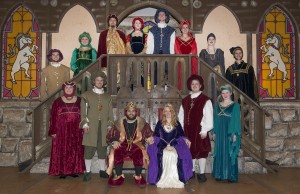“Dinner and a show” is a traditional evening out and there have been many groups throughout the history of performance offering this experience. Currently, there are still many organizations based on this concept and their practices are of both academic and professional interest to me. These venues tend to be more informal settings, suitable for families and casual attire. Dinner theatre is hence one of the most accessible and approachable performing arts, and is thus a great space to study the accessibility of the arts. There is a wide array of companies all over the United States, but consistently they each offer a casual environment though the ticket prices and meal costs vary between the groups, attracting different kinds of audiences and environments. The unique approachability of dinner theatre also generates some professional interest as far as considering the variety of organizations I could be involved in and learning how to promote such an experience.
Dinner theatre spans from the larger attractions to formal date ideas to a comfortable local spot. Tickets for most of these companies are typically less expensive than more formal spaces, but some can be pretty pricey. Many of these venues also have a theme, like Medieval Times or the Shakespeare Tavern. Some, however, are actually just non-specific theatres designed for dining. There are also variances between the companies based on their location and size. Dutch Apple in Lancaster, PA is actually a surprisingly large venue with rather pricey tickets. However, a lot of these organizations are smaller and very tied to their communities such as Lake George and The Station. Then there is Medieval Times- a large dinner theatre chain with a proprietary show and locations all over the country. Each company on this spectrum operates uniquely but still harkens back to the fundamental idea of dinner and a show.
In addition to live performance, there are also some movie theatres that offer dining such as Northern Lights in Salem, OR. This is a completely different side of dinner theatre. Going into Becker’s definition of art world, however, it is unclear whether or not these spaces should be included in the field guide. An art world, according to Becker, is primarily defined by the people involved. And since the artists involved in live dinner theatre are divergent from those involved in the movie houses, it is possible and seemingly preferable to separate these two. However, Becker states that “artists in various media-oriented worlds may try to achieve similar kinds of things in their work and may share ideas and perspectives on how to accomplish them” (Becker, 1982, 161). Theatre and film are both performative arts and thus have similar artistic challenges and goals. As such, these different crafts are part of the discussion on dinner theatre.
Another major resource in understanding dinner theatre is the National Dinner Theatre Association, or NDTA. Not all of the theatres listed above art members. The organization also does not include movie theatres. NDTA’s website (http://www.ndta.us/) offers insight on what exactly membership entails, which may in turn explain why some of these organizations are not members. The mix of members and non-members also points to how pleasantly expansive and varied the world of American dinner theatre is.


